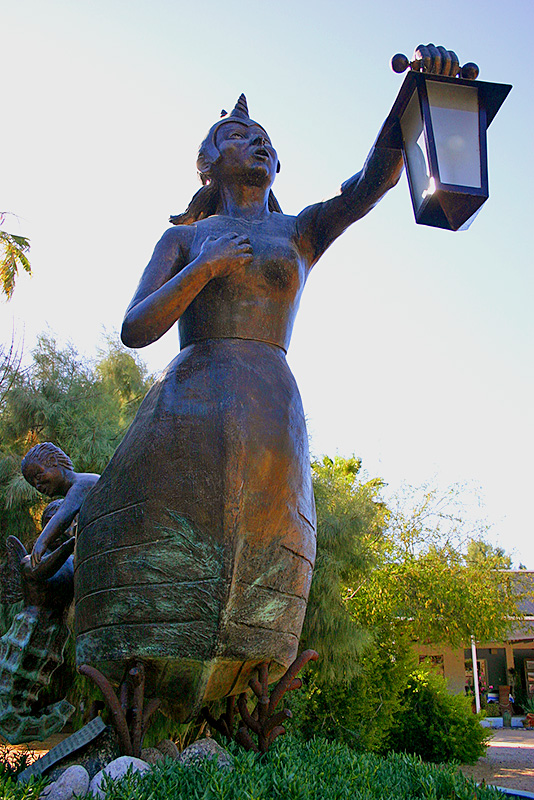The Sculpture of Benito Ortega
by Nathan Senge
Benito Ortega sits cross-legged in front of his new sculpture, his hands on his knees, his eyes strained. The piece has just been placed in the center of the NOS (Noroeste Sustentable) campus in La Paz, Mexico, and he hopes it will radiate hope into a moribund Manglito community ensconced in poverty and crime.
Made of bronze and gypsum, it features a stolid woman with brazen eyes holding out a lamp to the world. Her legs sweep back and fade into a skiff holding two children looking to her for guidance. Her hair swishes back in the wind as she steers the boat on. She exudes drive and compassion.

Benito says there is a lot of his mother in her; she is a “maker of history and a carrier of life.” “She is a brave woman for me,” he says, “a Warrior whose courage brings strength into the world. The children see in her direction, love, and tenderness—the kind of things kids need.”
A plaque below her reads: “women with the valor of the Warrior cross the sea of life, their bodies a loving transport bringing light to the world from the universal mystery of profound origin. ‘Poems for the Land.’ Benito Ortega V.”
When Benito placed the sculpture here instead of downtown astride his other works, he oriented the skiff’s with the summer solstice—how the NOS campus itself was designed.
“It was amazing,” a NOS staff member recounts. “He was only one or two degrees off perfect solar alignment.”
Benito chose NOS because he believes in its maternal qualities, in its kind and attentive rearing of children especially, which can provide the same needed guidance he received from his mentors at the Art Institute in Taxco, Guerrero, where he lived for twenty five years before cutting the ribbon on his La Paz studio.
“My mentors there believed in me. They offered feedback, and guidance, but ultimately just got out of my way and helped me go where I needed to go with my work. That is what this mother is doing for her children. And that is what NOS is doing with its gardens, sports camps, and schools. This is a place that cares about children. It’s also a place where they can begin to practice their own art in life.”
When asked if there was anything he would change about any of this, he shakes his head.
“It’s perfect,” he says. “Now all we need to do is extricate this struggling community from its self-spiraling demise. Recovering the clam and scallop stocks in the bay for the fishermen should do that, and I know they’re working hard at this. It’s good to see. It’s necessary.”
Indeed, people far and wide come to visit NOS and invariably end up congregating by the sculpture, often talking easily and with tones of reverence. “This is the stuff,” Benito says. “I wanted it to be a space for people. A place that helps them relax, and dream about what they want to do with their own lives, and this endangered community. I believe together we will find a vector through.”
Turn to the following story on the fisherman, Herubey Aviles, to learn more.

When Benito decided to place the sculpture here, instead of in downtown La Paz aside his other work, he was preicse in orienting the boat towards the summer solstice—how the NOS campus itself was designed.
“It was amazing,” a NOS staff member recounts. “He was only one or two degrees off perfect solar alignment.”
Benito chose NOS because he believes in its maternal qualities, in its kind and attentive rearing of children, which can provide the same kind of guidance he received from the art insitute in Taxco, Guerrero, where he lived for twenty five years before opening his own studio in La Paz.
“My mentors there believed in me. They offered feedback and guidance, but ultimately only wanted to help me, where they could, get to where I needed to go with my own work. That is what this mother is doing for her children. And this is what NOS is doing with its community gardens, camps, and educational offerings. This is a place that cares about children. It’s also a place where they can begin to practice their own art, which is essential to anyone.”
People visiting NOS are often seen congregating around the site, talking openly and observing the work.
“It’s good to see. I wanted it to be a communal space. A place that draws people. A place that helps them soar.”
Nathan Senge is a Contributing Writer at the Academy for Systems Change.
